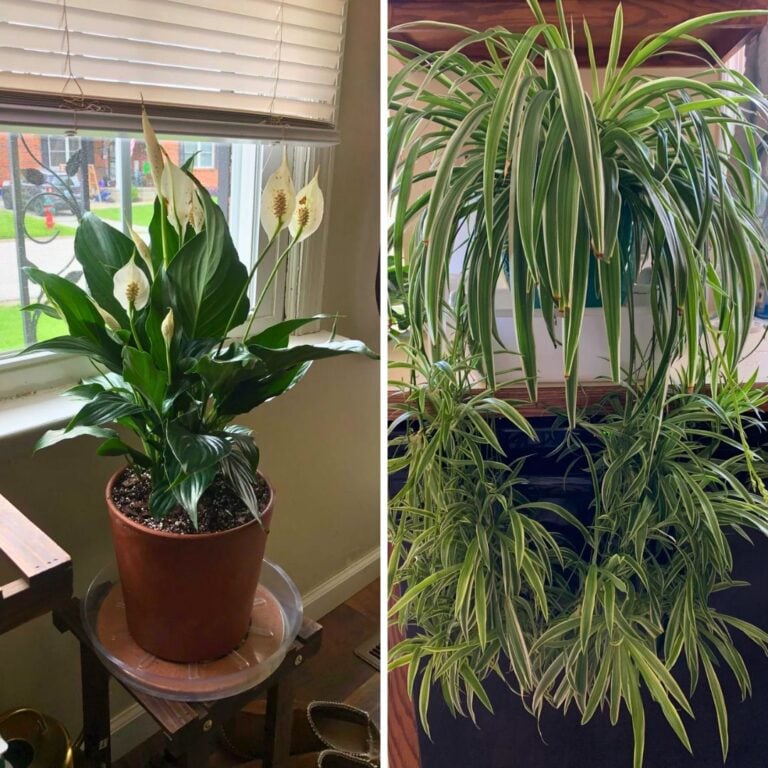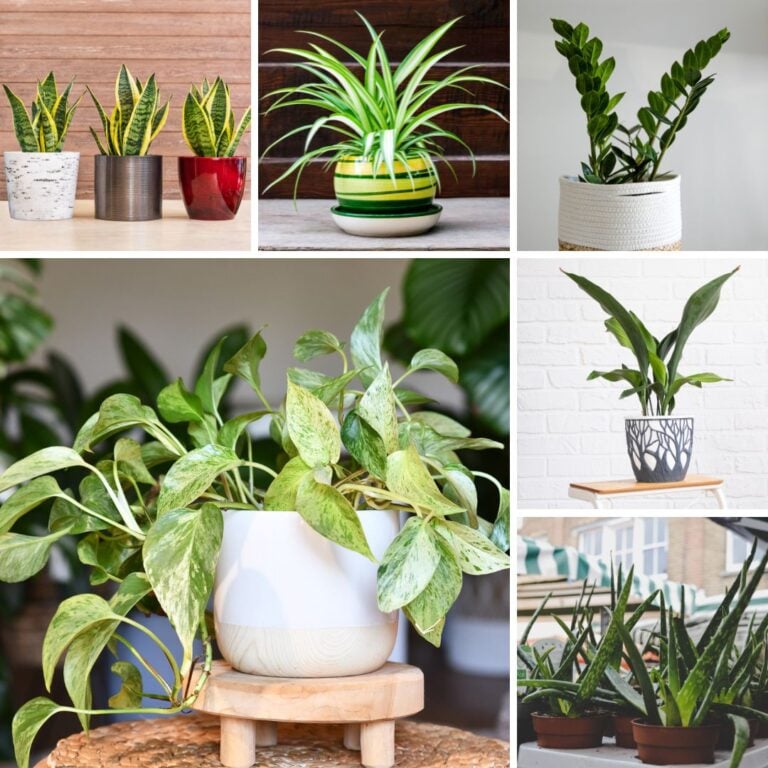18 Fast-Growing Climbing Plants for Balconies and Patios
Climbing plants can turn a plain balcony or patio into a green, lively haven. They grow fast, add color, and just make any outdoor spot feel more inviting.
You can easily create shade, privacy, and beauty with the right climbers. It’s honestly amazing what a few vines can do for a small space.
In this article, I’m sharing some of my favorite fast-growing climbers that fit small spaces and all kinds of styles.
Whether you want bold flowers, lush leaves, or something in between, you’ll find options here that grow quickly and are easy to care for.
Please note: Simplify Plants is reader-supported. As an Amazon Associate, I earn from qualifying purchases made by our readers with no extra cost added to you all! Some links in the post are affiliate links and I get a commission from purchases made through links in the post.
1) Clematis montana
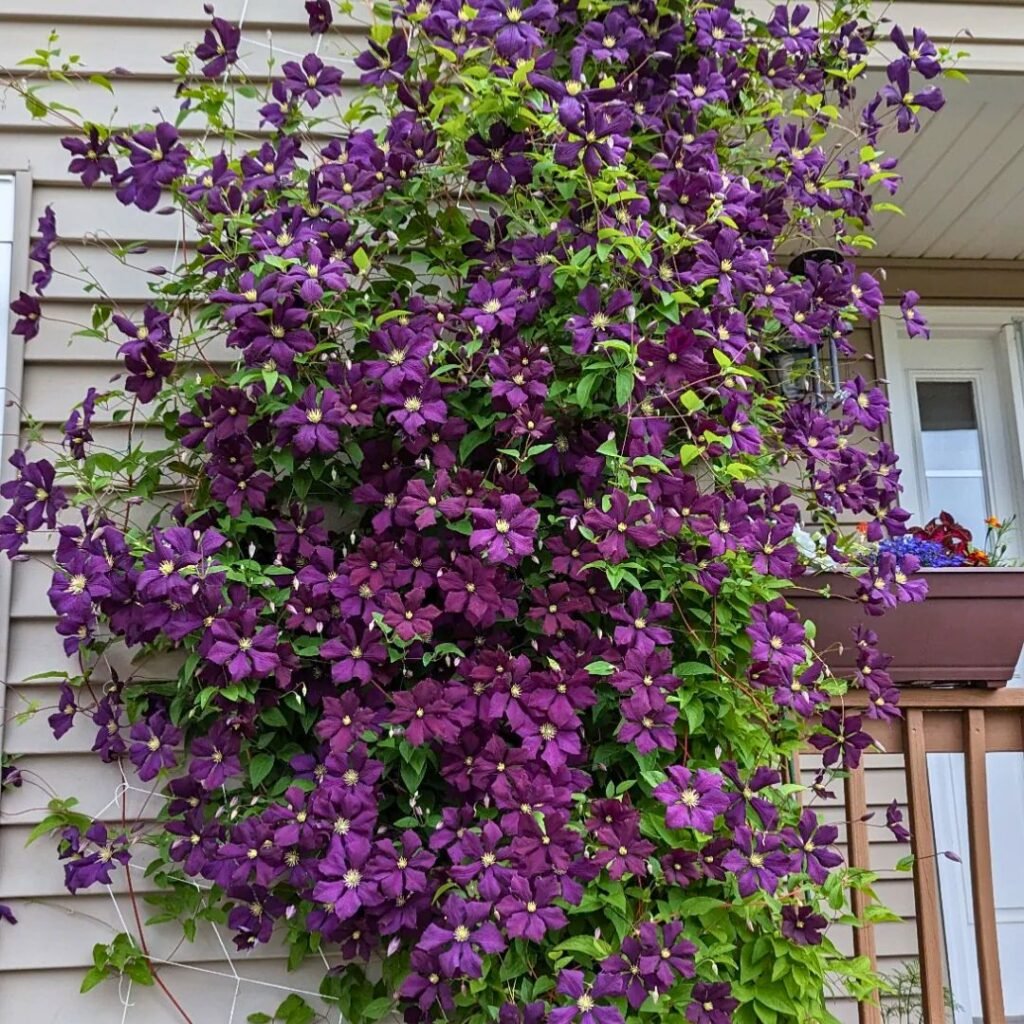
Clematis montana is one of those plants that just takes over—in the best way. It quickly covers fences, railings, or trellises with soft green leaves and pretty flowers.
It blooms in late spring, and the clusters of white or pale pink flowers have a gentle scent. Bees and butterflies love it, so my little balcony always seems busier when it’s in bloom.
I find it pretty easy to grow. It adapts well to different spots, loves full sun or partial shade, and just needs soil that drains well.
I water it regularly but try not to let the roots get soggy. Pruning right after flowering helps keep things tidy and encourages new growth.
I usually tie the stems to supports so they don’t tangle too much. Clematis montana softens hard surfaces and turns plain walls into blooming, green screens—privacy without sacrificing sunlight.
For a strong start, I plant it in a big pot with rich compost and a sturdy trellis. It can easily grow several feet each year, so you see results fast.
If you’re short on space, this climber adds height and color without hogging the floor. It’s honestly one of the simplest ways to make a balcony feel cozy and natural.
2) Boston Ivy

Boston Ivy is just so charming on a small patio or balcony. It’s a fast grower, quickly covering walls, fences, or trellises with lush green leaves.
Come fall, the leaves turn bright red and orange, and suddenly my space feels like it’s glowing. It’s a great way to add a splash of color without much effort.
It grows best in full sun to partial shade. More sun means deeper fall colors, but honestly, it’s not too picky about where it lives.
Boston Ivy climbs using tiny suction pads, so it can attach to brick, wood, or concrete—no extra support needed. I do check now and then to make sure it’s not damaging any painted walls, though.
I love that it’s low-maintenance. Once it’s established, I only water during dry spells and trim it once or twice a year to keep it neat.
This vine also gives natural shade and privacy, which is a bonus on hot days. Birds sometimes nest in the thick foliage, and that just makes the space feel even more alive.
Boston Ivy is perfect if you want quick greenery without a lot of fuss. The seasonal color changes keep my balcony looking fresh all year.
3) Trumpet Vine (Campsis radicans)
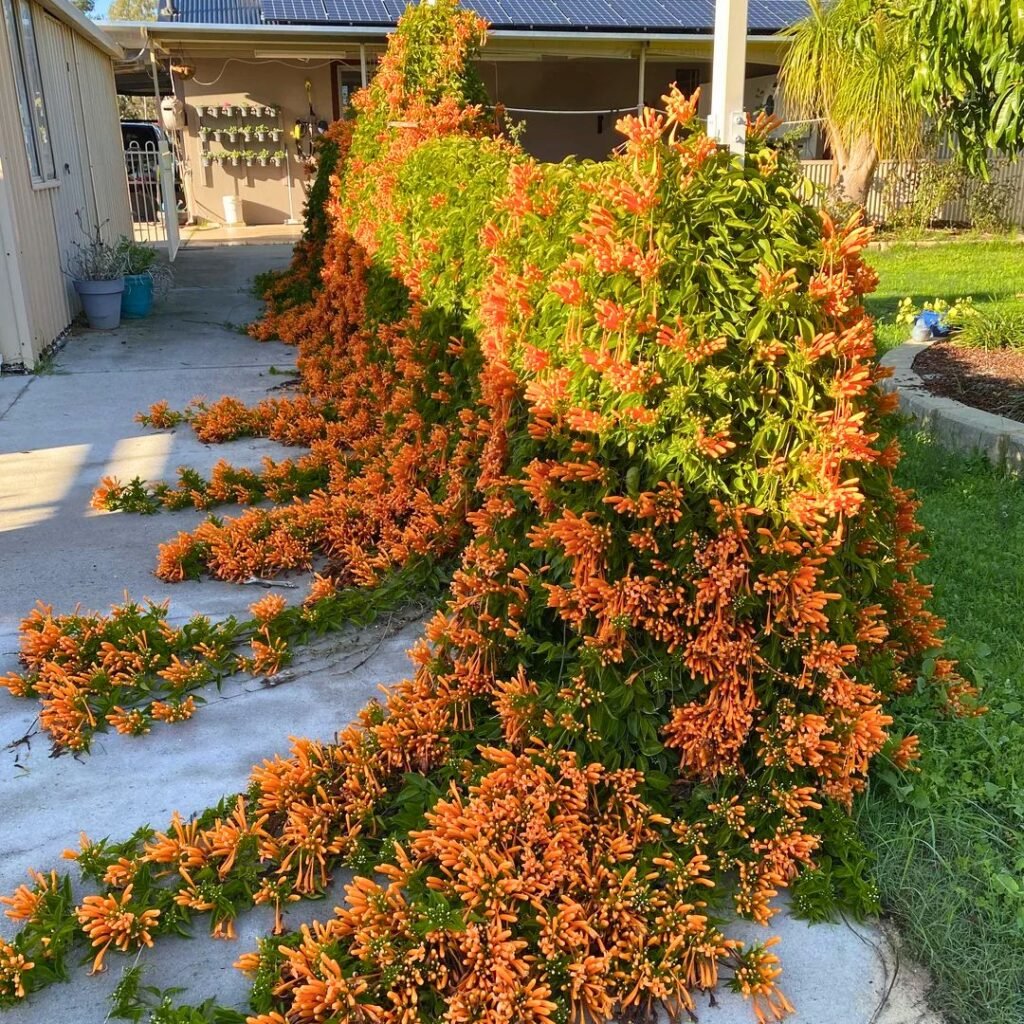
Trumpet Vine is a showstopper. Its orange-red flowers are bold and attract hummingbirds and butterflies, which is always fun to watch.
The blooms stand out from early summer through fall, making my balcony feel lively and a bit tropical. It grows fast and strong, so I give it a sturdy trellis or railing to climb.
I trim it pretty often to keep it from getting out of hand. It can cover a wall or fence in just one season, which is wild.
Trumpet Vine loves full sun and isn’t picky about soil. When it’s young, I water it regularly, but once it’s settled in, it handles dry spells just fine.
I like planting it in a large container to keep the roots from spreading too much. Even in a pot, it grows tall and full if it gets enough sun.
The flowers really pop against the green leaves and always catch my eye. Pruning after flowering keeps the plant healthy and encourages more blooms next year.
For anyone wanting a fast-growing climber that adds color and attracts wildlife, Trumpet Vine is a solid pick. It’s tough, beautiful, and doesn’t ask for much once you get the hang of it.
4) Honeysuckle (Lonicera periclymenum)
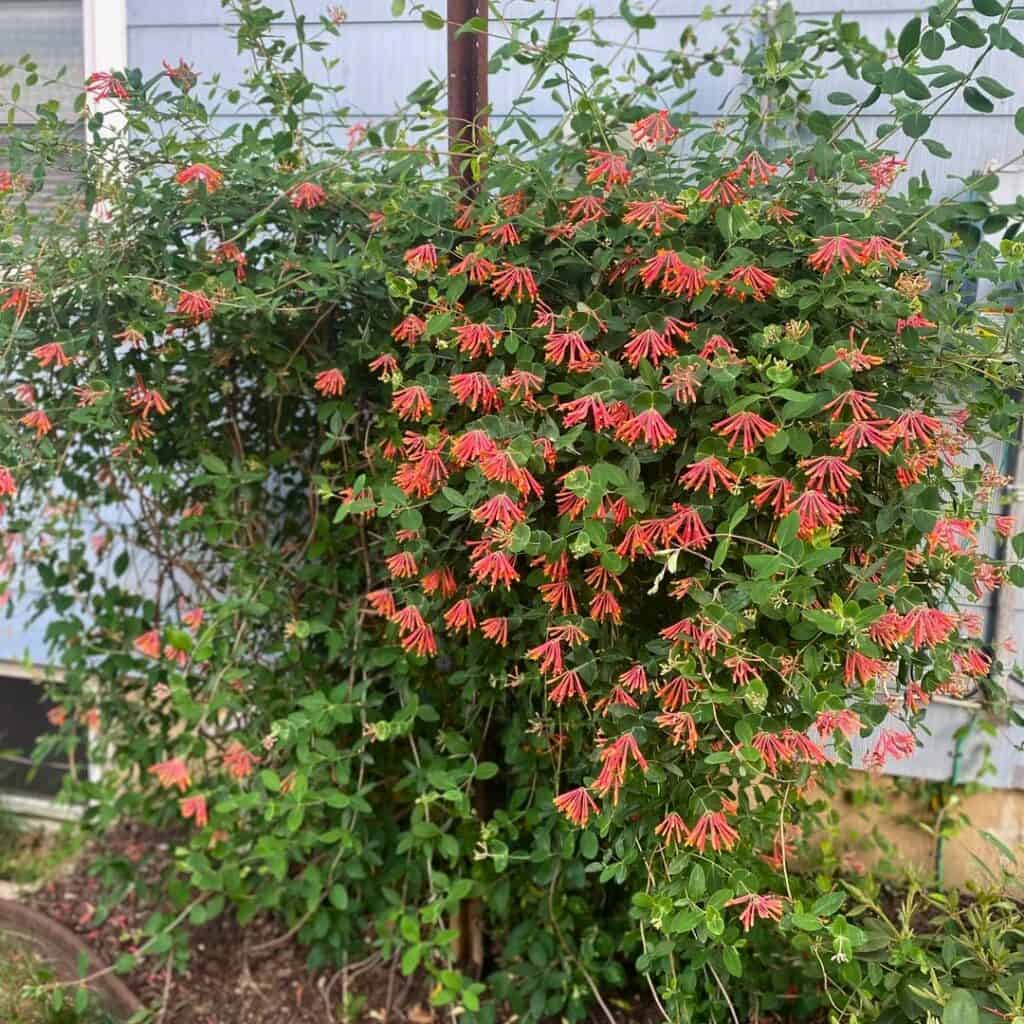
Honeysuckle is a favorite of mine for small spaces. It grows fast and fills patios or balconies with color and a sweet scent that’s hard to beat.
The flowers come in cream, yellow, and pink, and they attract bees, butterflies, and even the occasional hummingbird. It’s like a mini wildlife haven.
It’s easy to train on trellises or railings, and it can cover a bare wall in just one season if it gets enough sun. I usually give it full sun to partial shade and water it during dry spells.
When I plant honeysuckle in a big container, I use rich, well-drained soil. Pruning lightly after flowering keeps it neat and encourages new growth.
One thing I really like is how hardy honeysuckle is. It can handle cooler weather and still bounce back every year. The fragrance gets stronger in the evening, which is perfect for relaxing outside after sunset.
If I want more flowers, I’ll feed it with a balanced fertilizer in spring and remove old blooms. It’s a simple routine for lush vines and a scent that lasts all summer.
For small patios or balconies, it gives a natural screen and a bit of privacy. It’s honestly one of the easiest ways to bring a touch of the countryside into the city.
5) Wisteria sinensis

Wisteria sinensis is pure magic for balconies and patios. The hanging clusters of purple or white flowers look incredible in spring and early summer.
The blooms have a light fragrance that instantly makes the space feel calm and welcoming. It grows fast and strong, so I always use a sturdy trellis or railing for support.
It can quickly cover a wall or pergola, creating natural shade that keeps my seating area cool. Regular pruning is a must, though, or it’ll get a little wild.
Cutting it back after flowering helps it bloom again the next year. Wisteria loves full sun and well-drained soil—I water it often in dry spells but don’t let the roots sit in water.
I started mine in a large container with strong support, and it climbed fast. It started flowering in its second year, and those long blooms always impress guests.
With the right care, this vine can live for years and just gets more beautiful with time. The shade and flowers make it one of my top picks for small outdoor spaces.
6) Climbing Hydrangea (Hydrangea anomala petiolaris)

Climbing Hydrangea is perfect for shady spots or a balcony corner that needs some life. It’s a woody vine that clings to brick, wood, or stone with tiny rootlets—no trellis needed unless you want to guide it.
It’s a bit slow at first, but once it’s settled, it covers a wall or fence beautifully. The big, heart-shaped leaves stay green all summer and turn yellow in fall, which is a nice change.
In late spring or early summer, the flat clusters of white flowers show up. Bees and butterflies seem to love them, and the blooms have a light, sweet scent that makes the space feel more welcoming.
Climbing Hydrangea thrives in partial to full shade, which is great if your patio doesn’t get much direct sun. It likes moist, well-drained soil, so I water it during dry spells.
It’s a strong climber, so I check that my wall or railing can handle its weight as it matures. A light trim after flowering keeps it neat and under control.
This plant does well in containers too, as long as there’s enough room for the roots and a sturdy support to climb. It looks great trailing along a balcony edge or wrapping around a post.
I appreciate that Climbing Hydrangea is hardy and low-maintenance once it’s established. Even in winter, when the leaves drop, it keeps its structure.
If you want texture, flowers, and foliage without a vine taking over too quickly, this one fits the bill. It brings charm and greenery to small outdoor spaces without much fuss.
7) Star Jasmine (Trachelospermum jasminoides)

Star Jasmine is such an easy way to add charm to a small outdoor space. The glossy green leaves stay bright all year, and the white star-shaped flowers are just classic.
When it blooms, there’s this light, sweet fragrance in the air—especially in the evening. It’s subtle but really pleasant, perfect for winding down outside.
I usually grow Star Jasmine in a large pot with well-draining soil. It climbs easily with a trellis or railing, and if I want it to stay compact, a quick trim after flowering does the trick.
It grows best in full sun to partial shade and really thrives in warm spots with good airflow. It can handle short dry spells, but I water it regularly during hot months to keep the leaves shiny.
What’s nice is how low-maintenance it is. I barely have to fuss over it, and pests are pretty rare. A little pruning and some feeding in spring keep it looking great.
Star Jasmine can cover walls, fences, or balcony rails without eating up floor space. That’s perfect for small urban gardens where space is tight.
It softens hard surfaces and adds a relaxing vibe to any outdoor area. The plant grows steadily, not wildly, so I never worry about it taking over.
With evergreen leaves and that gentle scent, Star Jasmine gives my patio a calm, welcoming feel all year.
8) Passionflower (Passiflora caerulea)
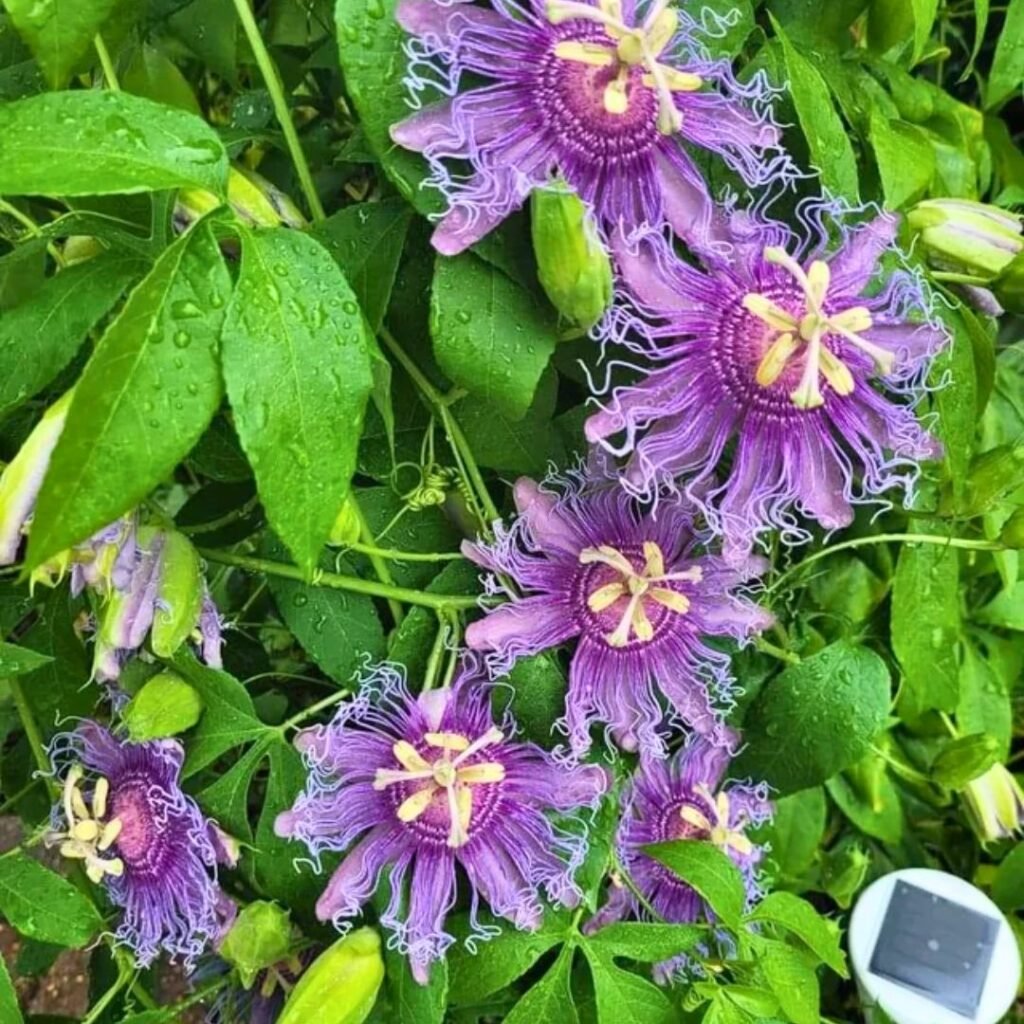
I just love how Passionflower brings instant charm to a balcony or patio. Those unique, star-shaped blooms in purple, white, and blue are such showstoppers.
The flowers look delicate, but the vine itself is surprisingly tough and grows fast. Give it a little support—a trellis, railing, or even some wire—and it’ll happily climb wherever you want.
It can stretch several feet in just one season if you give it enough sunlight and water. Full sun is best, though it’ll tolerate a bit of light shade if that’s all you’ve got.
I try to keep the soil moist but not soggy. Regular watering during dry spells keeps the leaves looking lush.
One of the best parts? Passionflower attracts butterflies and bees. There’s something special about seeing those visitors fluttering around. Sometimes you’ll even get fruit after the flowers, which is a fun bonus later in the season.
I give it a light prune now and then to keep it in check. It bounces back quickly, so I’m not too worried about overdoing it.
A little fertilizer in spring gives it a good head start. Even in cooler places, it can handle a bit of frost.
If winters get really cold, I’ll mulch the roots or bring the container inside just to be safe. It’s a hardy choice for lots of regions as long as you give it the basics.
For me, Passionflower is such a low-maintenance way to add color and texture to walls or fences. Its quick growth and striking flowers make it a top pick for small outdoor spaces.
9) Bougainvillea glabra

There’s something about Bougainvillea glabra that just brightens up a balcony or patio right away. Those vibrant pink, purple, or red bracts are impossible to ignore, and the tiny white flowers in the center make the colors pop even more.
It truly thrives in full sun. I make sure it gets at least six hours of direct light—otherwise, the blooms start to fade and it gets a bit leggy.
It needs well-draining soil to stay happy. I let the top layer dry before watering again, since too much moisture can lead to root rot.
For pots, I mix in some sand with garden soil so water doesn’t get trapped. When it’s warm, Bougainvillea glabra grows fast.
I trim it often to keep it from taking over, and pruning helps it bloom even more. Training the vines along a trellis or railing is pretty easy, and the thin stems wrap around supports without much fuss.
It’s a simple way to add privacy and a splash of color. Once it’s settled, this plant can handle heat and drought.
I don’t have to water every day, which is nice when life gets busy. When it gets cold, I move my potted bougainvillea to a sheltered spot.
It really doesn’t like frost, so a little extra care in winter goes a long way. Fertilizing every few weeks during the growing season keeps the colors bright.
I stick to a balanced, water-soluble fertilizer in small amounts—too much, and you’ll just get more leaves than flowers. I appreciate how low-maintenance it is once it’s established.
With sunlight, a bit of pruning, and occasional feeding, it gives me months of bold, beautiful color.
10) Sweet Pea (Lathyrus odoratus)

I grow Sweet Pea for its color and that unmistakable fragrance. The vines climb quickly and fill up empty spots with soft, fluttery blooms.
Their pleasant scent makes hanging out outside so much nicer. I usually plant Sweet Pea in spring when it’s still cool.
It likes full sun and well-drained soil. I keep the soil moist but not soggy, watering regularly if it gets dry.
A trellis or railing works well for support, and the vines will climb up with their curling tendrils. These plants can get pretty tall, so they’re great for adding vertical interest in small spaces.
Sweet Pea flowers come in all sorts of colors—pink, purple, white, red. I like mixing different shades for a cheerful look.
The blooms last longer if I remove faded flowers often. I start my seeds indoors a few weeks before moving them outside.
Soaking the seeds overnight helps soften the shell and gives better germination. Since Sweet Pea prefers cooler temps, I try to shield it from harsh summer heat.
When it gets too warm, the flowers might fade, so I give them morning sun and some afternoon shade. I like cutting a few stems for simple, fragrant bouquets indoors.
The more I cut, the more new blooms appear. Sweet Pea attracts bees and butterflies, so my balcony always feels lively.
It’s a small plant, but it’s rewarding—perfect for containers or hanging baskets. Feeding with a balanced fertilizer keeps the vines blooming longer.
I avoid too much nitrogen, since that just means more leaves. Sweet Pea gives my space a fresh, colorful look without taking up much room.
With a bit of care and a place to climb, it fills the balcony with soft petals and a gentle scent.
11) Black-eyed Susan Vine (Thunbergia alata)
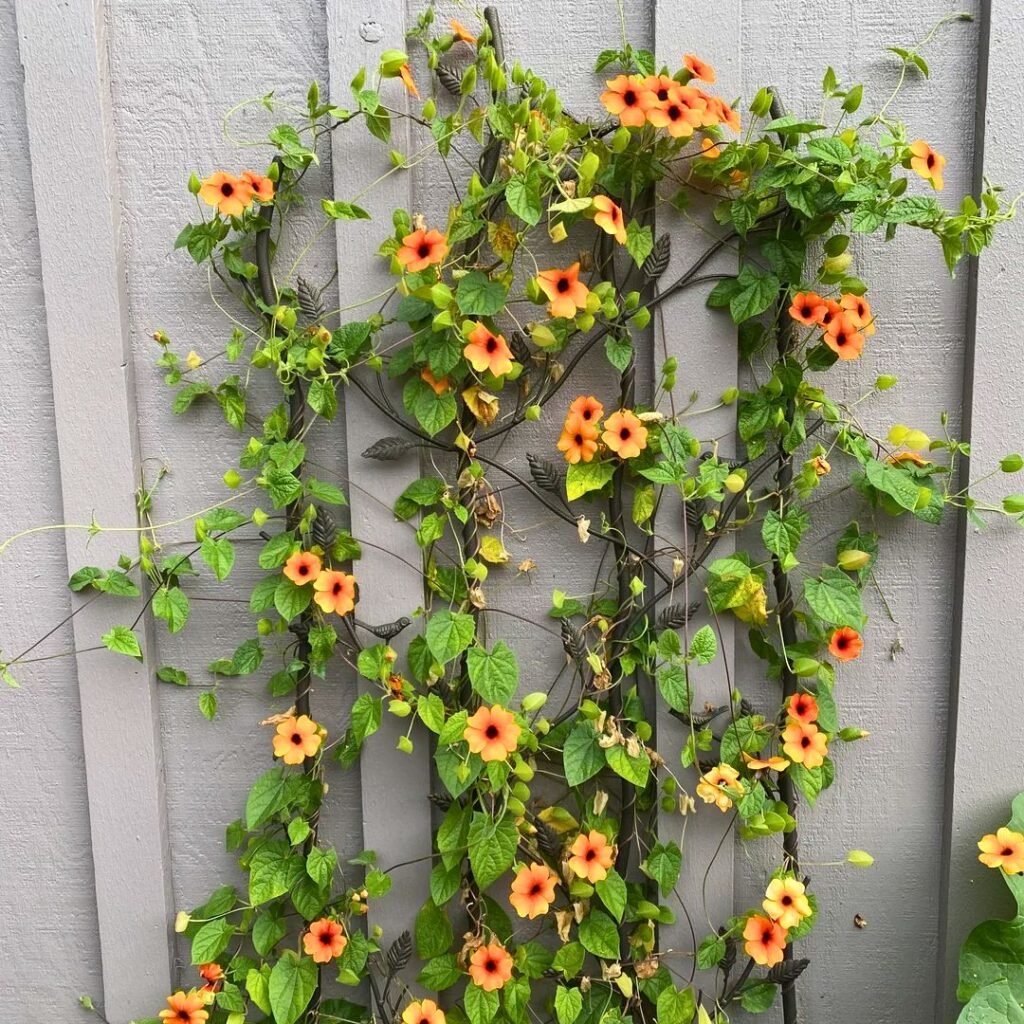
The Black-eyed Susan Vine brings instant color to any small space. Its bright yellow-orange flowers with dark centers really pop against the green leaves.
This vine grows quickly, which is perfect for balconies, patios, or fences that need a little something extra. I usually put it in a sunny spot because that’s where it blooms best.
Partial shade is okay, but I see fewer flowers without enough sun. It climbs easily if you give it a trellis or railing to hold onto.
I keep the soil moist but not soggy, especially during the warmer months. Well-draining soil and a light fertilizer every few weeks seem to do the trick.
When I grow it in a pot, I always use a container with drainage holes to avoid root rot. The vine can hit about 6 to 8 feet long, so it needs a little space to spread.
It’s easy to trim if it gets out of hand. I like using it in hanging baskets too—the vines trail down and create a soft curtain of flowers.
It looks cheerful with hardly any effort. In cooler areas, I treat it as an annual since it can’t handle frost.
In warmer places, it can grow all year. Either way, it fills empty spaces fast.
Starting Black-eyed Susan Vine from seeds is a breeze. They sprout in a couple of weeks if kept warm and slightly damp.
Once the seedlings are strong, I move them outside after the last frost. The flowers attract butterflies and bees, which makes my balcony feel more alive.
It’s a low-maintenance plant. As long as I water it and give it sun, it rewards me with bright blooms all summer.
Definitely one of my favorite vines for small outdoor spaces.
12) Morning Glory (Ipomoea tricolor)

Morning Glory brings quick color and life to a small space. This vine grows fast, covering railings, fences, or trellises with heart-shaped leaves and those bright, trumpet-shaped flowers.
I plant it in a sunny spot since it really needs full light to bloom well. The flowers usually open in the morning and close up by afternoon—hence the name.
It’s pretty easy to start from seeds, which sprout quickly in warm soil. I like to soak the seeds overnight to help them germinate faster.
Once the vines start climbing, I’ll guide them with string or wire. They can reach several feet in just a few weeks, making a nice, soft green screen.
I water regularly, but I make sure the soil drains well. Too much water can cause root rot, so I wait until the top inch feels dry.
Morning Glory does great in containers, which is perfect for balconies or patios. I usually go with a large pot and a sturdy trellis to support it.
The flowers come in blue, pink, purple, and white, bringing cheerful color to any outdoor area. I love seeing fresh blooms every morning during the warmer months.
I pick off faded flowers to keep things tidy and stop too many seeds from forming. That way, it keeps blooming longer.
Since it grows so fast, I trim it back if it starts tangling with other plants. A little pruning helps keep it healthy.
Bees and butterflies often stop by, which is always nice to see. While Morning Glory is beautiful, I keep it in pots to manage its growth—it can spread if you let it.
For a simple, fast-growing vine that adds daily color, Morning Glory is one of my go-tos for balcony and patio spaces.
13) Dutchman’s Pipe (Aristolochia macrophylla)

Dutchman’s Pipe brings a bold, leafy look to any balcony or patio. Its large, heart-shaped leaves create thick coverage for instant privacy and shade.
This vine grows fast, especially in warm weather, so it’s great for small outdoor spaces that need a quick green boost. I find it climbs best on strong supports like trellises, fences, or pergolas.
The stems can get heavy, so I make sure the structure is sturdy. The vine wraps around supports with twining stems, which makes it easy to train.
The flowers are pretty unusual—shaped like curved pipes, which is where the name comes from. They’re usually greenish-yellow or brownish-purple and look fascinating up close, even if they’re not super showy from afar.
Dutchman’s Pipe prefers partial shade and moist, well-drained soil. It can handle some sun, but too much heat can make the leaves wilt.
I water it regularly, especially during dry spells, to keep the foliage lush. Once it’s established, it’s pretty low-maintenance.
I prune it in late winter or early spring to control the size and shape. It grows back quickly and fills in any gaps by summer.
I also like how it helps reduce heat on balconies by shading walls and railings. The thick leaves act as a natural screen, which keeps the area cooler.
For anyone wanting a fast-growing, leafy vine with a unique vibe, Dutchman’s Pipe is a solid choice. It adds character, privacy, and greenery without much fuss.
I always recommend it to anyone looking for a natural, easy way to make their balcony or patio feel more inviting.
14) Ivy (Hedera helix)

I just love how ivy grows so quickly—it brings instant greenery to even the smallest spaces. It’s honestly one of the easiest climbing plants I’ve tried, and it seems happy in both sun and shade.
Those dense leaves make a natural screen, which is perfect for a bit of privacy on my balcony. The leaves stay green most of the year, so there’s always a splash of color, even when it’s cold out.
I usually go for pots or hanging containers with good drainage. Ivy climbs easily if I give it something to grab, like a trellis, railing, or even just a wall.
I’ve learned to trim it often since it can get out of hand pretty fast. Regular pruning keeps things neat and stops it from smothering other plants.
Once it’s settled, ivy doesn’t need much water. I just try to keep the soil slightly moist and wait for the top layer to dry out before watering again.
English ivy is tough and grows well in all sorts of climates. It also helps reduce dust and improve air quality, which makes my outdoor space feel fresher—always a bonus.
For a softer vibe, I let ivy trail down from a shelf or the edge of the balcony. When the wind catches those hanging vines, it just makes everything feel calmer.
I avoid planting ivy straight into the ground near walls, since it clings so tightly and can be a pain to remove. Keeping it in containers gives me way more control.
Ivy looks great with flowering plants like petunias or geraniums—the green really makes their colors pop.
I always wear gloves when trimming since the sap can irritate my skin. With just a little care, ivy stays healthy and looks good all year.
Even in tiny spaces, ivy brings in a touch of nature and texture that just makes my balcony feel more relaxing. It’s such a low-maintenance way to add life to any patio.
15) Jasmine (Jasminum polyanthum)
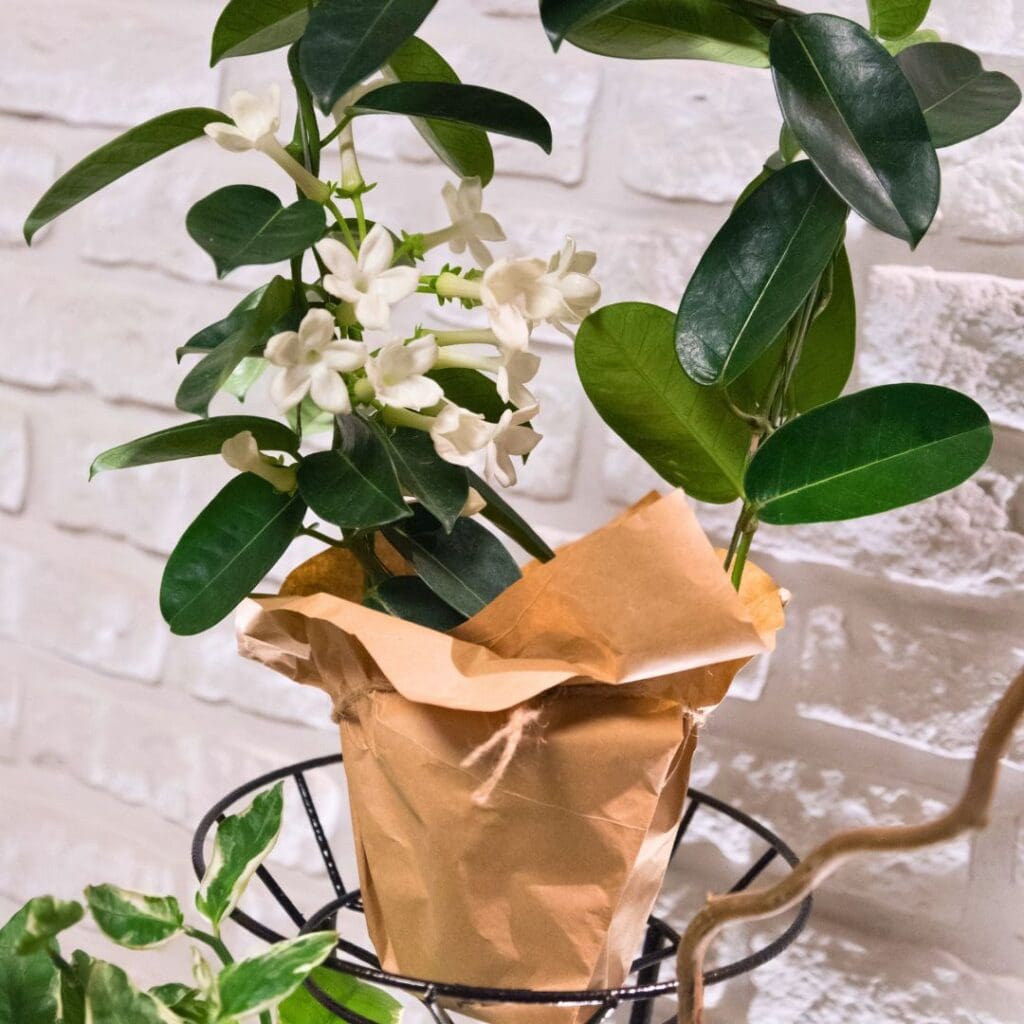
I can’t get enough of how Jasmine fills the air with its sweet scent. This fast-growing climber brings such a soft, floral fragrance that makes any balcony or patio feel instantly welcoming.
Jasminum polyanthum takes off once it gets enough sunlight. It likes bright, indirect light, and a few hours of sun each day really helps. Partial shade works, but if it’s too dark, it just doesn’t grow as fast.
The plant can get pretty long in just one season. I usually guide its vines along a trellis or railing to keep things tidy. The thin stems wrap around wires or stakes without much fuss, so shaping it is a breeze.
I water jasmine when the top inch of soil feels dry. It likes moist, well-drained soil, but not soggy roots. On a balcony, the soil dries out quickly during summer, so I check it often.
In early spring, I trim back old growth to make room for new shoots and more flowers. Regular pruning keeps the plant bushy and stops it from getting tangled.
When it blooms, those small white-pink flowers cover the vines and attract bees and butterflies. The blossoms usually show up in late winter or early spring, which is great when other plants are still waking up.
I like growing jasmine in a container so I can move it around and control the soil. If it gets too cold, I just bring it inside to protect it from frost—it really hates freezing temperatures, so I keep it somewhere warm and bright.
During the growing season, I feed it every few weeks with a balanced liquid fertilizer, just diluted in water. Too much fertilizer can actually mean fewer blooms, so I keep it light.
Jasmine always looks best when it’s got room to climb. Even a small space works if I give it a vertical frame. The vines grow fast, so I have to check in and tidy them up now and then.
For anyone after a fragrant, fast-growing climber, jasmine is such a solid pick. It’s easy to care for, looks beautiful, and the scent just makes time outside feel a bit more special.
16) Virginia Creeper (Parthenocissus quinquefolia)

I’m a big fan of how Virginia Creeper quickly brings green life to a balcony or patio. It’s a tough vine that grows fast and can cover a wall, trellis, or railing in just a season. Those five-part leaves give a full, leafy look that stays fresh through spring and summer.
In fall, the leaves turn bright red—honestly, it’s one of my favorite things about this plant. The little dark berries that follow attract birds, which adds a bit of movement and nature to the space.
Virginia Creeper is pretty flexible about light, growing well in sun or partial shade. It’s not fussy and doesn’t need much attention once it’s established. I’ve seen it handle all sorts of soils and weather, so it’s a good choice if you’re just starting out.
I use it to create privacy on my balcony. The thick leaves make a green screen that blocks out unwanted views and softens up any hard edges. Plus, it helps cool things down by shading walls and railings during hot days.
This plant climbs with small adhesive pads at the tips of its tendrils. They stick to most surfaces—brick, wood, you name it. I try to guide the vines early so they grow where I want.
Virginia Creeper can get out of hand if I’m not careful, so I trim it often to keep things neat. It’s easy to shape and bounces back nicely after a good cut.
At first, I water it regularly, but once it’s settled in, it can handle some dry spells. Adding a layer of mulch helps keep the soil moist and keeps weeds away.
For pots, I use a large container with good drainage. The roots like some space, and healthy roots mean better growth. I’ll feed it with a balanced fertilizer once or twice a year to keep the leaves looking great.
It’s honestly one of the most low-maintenance climbers I’ve grown. Quick coverage, bold color, and seasonal changes—all with very little effort. For small patios or tall walls, Virginia Creeper is one of my top picks for easy greenery.
17) Climbing Rose (Rosa spp.)

I really enjoy how climbing roses bring color and a bit of romance to small outdoor spaces. Their blooms pop against walls, fences, or railings, turning plain spots into cheerful corners. They grow fast once they settle in, especially with good sunlight and a little attention.
I like to plant them in large containers with rich, well-drained soil. They need at least six hours of sun each day to really put on a show. I water them deeply, then let the soil dry out a bit before watering again.
To keep them in shape, I prune old or weak stems every year. That way, new shoots can grow and the plant stays tidy. I also tie the canes to a trellis or railing so they climb where I want them to go.
Climbing roses come in all sorts of colors and flower shapes, from soft pinks to deep reds and creamy whites. Mixing varieties means I get blooms at different times, which keeps things interesting. Many have a light, pleasant scent too, which makes sitting outside even nicer.
I’ve noticed that fertilizing in spring and midsummer helps them grow strong and bloom more. A balanced rose fertilizer does the trick.
Even with limited space, a climbing rose can make a big impact. It’s one of my favorite ways to add natural beauty and structure without using up much floor space.
18) Silver Lace Vine (Polygonum aubertii)

I’m always impressed by how Silver Lace Vine quickly covers fences, trellises, and railings with its soft green leaves and little white flowers. It grows fast—lush coverage in just one season, honestly.
This vine can get up to 25 feet long, so it needs some serious support. I like to train it along a balcony railing or over a pergola for a natural screen. The flowers start blooming in late summer and keep going into fall, adding a light, airy feel.
It’s easy to care for, which is a relief. It loves full sun but does fine in partial shade too. I water it regularly during dry spells, though it can handle a bit of drought once it’s settled.
Every year, I trim it back to keep things tidy and stop it from taking over. Pruning actually helps it grow back fuller and with more flowers.
Because it grows so quickly, I keep an eye on it so it doesn’t crowd out other plants. With a bit of attention, my Silver Lace Vine stays healthy and looks good all season.
The delicate white blooms really brighten up my patio and attract bees and butterflies. It’s such an easy way to add life and texture without much effort.
Choosing the Right Climbing Plant for Your Space
Before I pick a climbing plant, I look at light, growth habits, and what kind of container setup I can handle. These things really make a difference in how well the plant grows and how much work it’ll need.
Assessing Sunlight and Shade
First, I check how much sunlight my balcony or patio actually gets. Most flowering climbers, like morning glory or bougainvillea, want at least six hours of direct sun.
Shade lovers, such as ivy or star jasmine, do better in partial or even full shade. I usually take note of which spots are sunny or shady at different times—morning, noon, and late afternoon.
It’s not a perfect science, but it helps me match the plant’s needs to the space. If the light is kind of mixed, I’ll go for something adaptable like clematis.
Walls and railings can bounce back heat, which dries out plants faster—something to keep in mind.
| Light Level | Recommended Plants | Care Tip |
|---|---|---|
| Full Sun | Bougainvillea, Morning Glory | Water more often in hot weather |
| Partial Shade | Clematis, Honeysuckle | Support stems as they grow |
| Full Shade | Ivy, Star Jasmine | Avoid overwatering |
Considering Growth Rate and Maintenance
I think about how fast I want things to fill in. Fast growers like black-eyed Susan vine or sweet pea will cover a space quickly, but they might need more trimming to stay neat.
Slower growers, like climbing hydrangea, don’t need as much pruning but take their sweet time. If I’m busy, I go for easy-care options—some climbers drop leaves or need frequent tying, which can get old fast.
I check how often each type needs pruning, feeding, and watering before I commit. Regular maintenance keeps plants healthy and stops them from wrecking walls or railings.
A quick weekly check for dead leaves or pests usually does the trick.
Container Size and Support Structures
I always try to match the container size to the plant’s roots. Deep-rooted climbers like wisteria want big pots, while lighter vines like sweet pea are fine in smaller ones.
Good drainage is a must—those drainage holes save a lot of headaches. For supports, I use trellises, wires, or mesh panels depending on how heavy the vine gets.
If it’s a chunky vine, I go with sturdy metal or wood supports and make sure they’re anchored well. I leave a bit of space between the pot and wall for air flow—keeps things dry and cuts down on mold.
When the setup feels right, the plant just looks better and grows more evenly.
Caring for Climbing Plants on Balconies and Patios
I do my best to keep my climbing plants healthy by watering them right, feeding when needed, trimming, and keeping an eye out for pests or harsh weather. These steps really help them stay strong and green.
Watering and Feeding Tips
I try to water my climbing plants regularly but not too much. Most of them like moist soil, but soggy roots are a no-go.
If the top inch of soil is dry, I water. On hotter days, I do it in the morning—it just feels right and keeps evaporation down.
Containers with drainage holes are a lifesaver. For feeding, I’ll use a balanced liquid fertilizer every couple of weeks during the growing season. In winter, I ease up since the plants aren’t growing much.
Every plant’s a little different, so I actually read the care label (even if it feels silly). For example:
| Plant Type | Watering Frequency | Fertilizer Type |
|---|---|---|
| Ivy | Moderate | Balanced 10-10-10 |
| Jasmine | Frequent | High-phosphorus |
| Clematis | Moderate | Organic compost mix |
Pruning for Healthy Growth
I prune my climbing plants to keep them in check and encourage fresh growth. Without it, vines get tangled and block out their own sunlight.
I start by snipping dead or weak stems, then trim back long shoots to shape things up. Clean, sharp shears are a must—dull ones just make a mess.
For flowering vines, I prune right after blooming so I don’t accidentally cut off next year’s flowers. As new shoots pop up, I tie them to supports so they grow where I want.
Regular pruning keeps the balcony looking neat and the plants fuller.
Protecting Plants from Pests and Weather
I’m always on the lookout for aphids, spider mites, or whiteflies. If I spot any, I’ll spray the leaves with water and a little mild soap.
If things get out of hand, I’ll use neem oil or another natural insecticide. For strong winds, I weigh down pots or move them close to walls.
When it gets cold, I’ll tuck containers into sheltered spots or wrap them with burlap. I also watch for leaf spots or mildew—good air flow and not watering the leaves directly usually helps.
Staying alert to small changes lets me act before things get worse.
Frequently Asked Questions
Fast-growing climbers can turn a small space into a little green hideaway. The right plants, a bit of sunlight, and solid support really do make a difference.
What are some quick-growing climbers that can thrive in pots?
I like Clematis montana, Boston Ivy, and Honeysuckle—they grow fast and don’t mind being in containers. I pick big pots with good drainage so the roots stay happy.
How do I choose the right climbing plant for my balcony’s sunlight conditions?
I try to match each plant to the light it wants. Wisteria sinensis and Trumpet Vine love full sun, while Boston Ivy is fine with partial shade. I always check how much sun my balcony really gets before planting.
Can you suggest some fast climbers that are also great for creating privacy?
Trumpet Vine and Honeysuckle are my go-tos—they fill in quickly and make a nice, thick screen. Plus, they add some color and scent, which is a bonus.
What care tips should I follow to ensure my climbing plants grow quickly and healthily?
I water often, but not so much that the soil stays wet. Feeding with a balanced fertilizer during the growing season helps a lot, and I always trim off dead or tangled stems to keep things vigorous.
Are there any flowering climbers that will bloom quickly for outdoor spaces?
Clematis montana and Honeysuckle bloom early and add color in the first season. I look for varieties that flower fast so I don’t have to wait ages for blooms.
How can I support my climbing plants as they grow taller?
I usually go for trellises, wires, or even balcony rails to help the vines find their way up. Sometimes I’ll tie the stems with a bit of soft string—just loose enough so they don’t get squished, but still have some support.
Recommended Garden Supplies
| Product Image | Our Recommended Gardening Supplies | Check Offers! |
|---|---|---|
Top Top
Top
Top
Top
Top
Top
Top
Top | rePotme Houseplant and Tropical Classic Potting Soil Mix | Check Offer On Amazon |
 Top
Top
Top
Top
Top
Top
Top
Top | Espoma Organic Indoor Plant Food | Check Offer On Amazon |
 Top
Top
Top
Top
Top
Top
Top
Top | GooingTop LED Grow Light 6000K Full Spectrum Clip Plant Growing Lamp | Check Offer On Amazon |
 Top
Top
Top
Top
Top
Top
Top
Top | Soil Moisture Meter | Check Offer On Amazon |
 Top
Top
Top
Top
Top
Top
Top
Top | Govee Hygrometer Thermometer, Bluetooth Enabled! | Check Offer On Amazon |
 Top
Top | LEVOIT Humidifiers for Large Room(Best For Plants) | Check Offer On Amazon |
 Top
Top
Top
Top
Top
Top
Top
Top | Upgraded DIY Automatic Drip Irrigation Kit, 15 Potted Houseplants Support | Check Offer On Amazon |
 Top
Top
Top
Top
Top
Top
Top
Top | Stainless Steel Heavy Duty Gardening Tool Set | Check Offer On Amazon |
 Top
Top
Top
Top
Top
Top
Top
Top | Bonide Insecticidal Soap | Check Offer On Amazon |
 Top
Top
Top
Top
Top
Top
Top
Top | Bonide 32 oz Spray Neem Oil for Organic Gardening | Check Offer On Amazon |
 Top
Top
Top
Top
Top
Top
Top
Top | Garden Safe Fungicide | Check Offer On Amazon |
Note: Some images in the articles are sourced from Reddit and Other Platforms For Reference Purpose.

